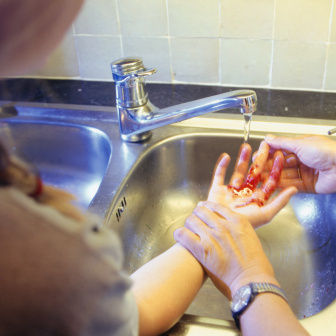03.A.05 Blood-Borne Pathogen (BBP) Program.
Employees designated as responsible for rendering first aid or medical assistance must be included in their employer's BBP program in accordance with 29 CFR 1910.1030 and must:

- Be instructed in the sources, hazards, and avoidance of BBPs and be provided the training specified in 29 CFR 1910.1030;
- Be provided with, and must use and maintain, PPE (i.e., breathing barrier, latex-free gloves, gowns, masks, eye protectors, and/or resuscitation equipment) when appropriate for rendering first aid or other medical assistance to prevent contact with blood or other potentially infectious materials;
- Institute a site-specific BBP program to include a site-specific Exposure Control Plan with provisions for engineering and administrative controls, Hepatitis B vaccination, PPE, training, recordkeeping, and a Post-Exposure Control Plan in the event of a blood-borne exposure. Post-exposure protocol must include a plan to ensure immediate medical evaluation of exposed individual(s) per current recommendations of the Center for Disease Control (CDC) for human immunodeficiency virus (HIV), Hepatitis B virus (HBV), and Hepatitis C virus (HCV).
03.A.06
Prior to the start of work outside the employee's normal geographical area, the employer must inform employees of parasitic, bacterial, viral and environmental diseases endemic to the geographical work location (i.e., Lyme Disease, West Nile Virus, Hantavirus, Histoplasmosis, Rocky-Mountain Spotted Fever, Dengue Fever, Malaria, etc.)
- For guidance on the potential biological and environmental diseases in the work location, the employer must consult the CDC Travel webpage, U.S. Army Public Health Command - Institute of Public Health web site, and the health department in the local area.
- Information to be provided to the employee traveling in areas where such diseases are endemic must include:
- (1) Modes of disease transmission;
- (2) Specific health risks associated with the disease;
- (3) Preventive measures such as available vaccines and PPE (gloves, eye and skin protection, respirator);
- (4) Appropriate work practices to prevent contact with infected agents (bird/rodent droppings, etc.), such as watering areas prior to dust-generating activities;
- (5) Vaccine information, to include information on the effectiveness, risk, and availability;
- (6) Safe removal of source where applicable;
- (7) Symptom recognition and medical referral.
Knowledge Check Choose the best answer for the question.
3-4. Which of the following is true concerning the Bloodborne Pathogens Program (BBP) and Exposure Control Plan?
You forgot to answer the question!
